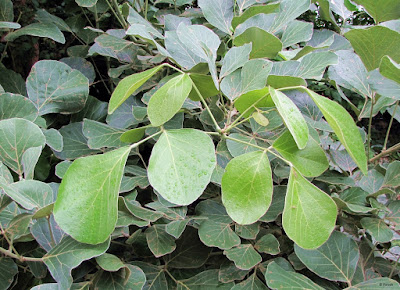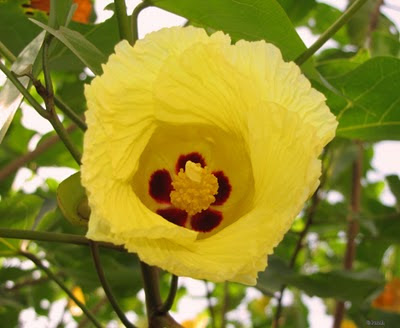The name itself suggests a lot about the tree. At the beginning of the summer, the leafless tree flowers abundantly and the scene appears very conspicuous in the forest. When the tree is in its fullest beauty, it can change the view of entire forest. Palash or Parrot tree (Butea Monosperma/पळस) is the state flower of Madhya Pradesh as well as Jharkhand.
It is a very beautiful tree with bright crimson orange coloured flowers and is noticeable even from long distance. It is said that the nature also plays Holi, the Indian festival of colours, as the tree flowers somewhat in same period. It is a bliss to have this tree, not only for human eyes owing to its beauty but for birds & squirrels also. Even when the tree is not in bloom, it is frequently visited by number of birds.
Palash is a sacred tree, referred to as treasurer of Gods and symbolise the moon. The flowers are offered as in place of blood in sacrifice rituals to Goddess Kali. The tree is said to have sprung from the feather of a falcon impregnated with the Somarasa, the beverage of the Gods and thus immortalised. When a Brahmin boy becomes a Sadhu, his head is shaved and he is given a Palash leaf to eat..the trifoliate formation representing Lord Vishnu in the middle, Lord Brahma on the left and Lord Shiva on the right. It is even used in Hindu ceremonies for the blessing of calves to ensure their becoming good milkers.
This decorative tree thrives well on a wide variety of soils including shallow, stony sites, black cotton soil, clay loams, and even in salt lands & water logged places. It coppices well & is resistant to browsing. The tree is very drought resistant and frost hardy. It is easily propagated by seeds and grows rapidly in full sunlight.
 The various parts of Palash have numerous uses. It is used for resin, fodder, medicine and dye. In India, being fairly rich in nutrients, its young leaves are good fodder, eaten mainly by buffaloes. The fibre obtained from the tree is made into ropes & cordage. The gum from the tree, called Kamarkas in Hindi, is used in certain food dishes. The gum is also considered valuable by druggists because of its astringent qualities and by leather workers because of its tannin. The flowers are used to prepare traditional Holi colour. A bright yellow to deep orange-red dye is also prepared, used especially for dyeing silk & cotton. This dye is used by Hindus to mark the forehead. Medicinally also, its flowers are useful in the treatment of liver disorders. Its seeds has anthelmintic, bactericidal & fungicidal properties. Its leaves are believed to have astringent, depurative, diuretic and aphrodisiac properties. It promotes diuresis & menstrual flow.
The various parts of Palash have numerous uses. It is used for resin, fodder, medicine and dye. In India, being fairly rich in nutrients, its young leaves are good fodder, eaten mainly by buffaloes. The fibre obtained from the tree is made into ropes & cordage. The gum from the tree, called Kamarkas in Hindi, is used in certain food dishes. The gum is also considered valuable by druggists because of its astringent qualities and by leather workers because of its tannin. The flowers are used to prepare traditional Holi colour. A bright yellow to deep orange-red dye is also prepared, used especially for dyeing silk & cotton. This dye is used by Hindus to mark the forehead. Medicinally also, its flowers are useful in the treatment of liver disorders. Its seeds has anthelmintic, bactericidal & fungicidal properties. Its leaves are believed to have astringent, depurative, diuretic and aphrodisiac properties. It promotes diuresis & menstrual flow.
 There is an interesting fact about the leaves of Palash. The tree provides leaves that are used with many pieced together to make a leaf-plate for serving a meal over. And in tribal communities, a would be son-in-law is tested on his dexterity in making this plate and bowl (for serving more liquid parts of the meal such as daal). If one could make it gracefully, then he is declared to be acceptable by the would be father-in-law. :-)
There is an interesting fact about the leaves of Palash. The tree provides leaves that are used with many pieced together to make a leaf-plate for serving a meal over. And in tribal communities, a would be son-in-law is tested on his dexterity in making this plate and bowl (for serving more liquid parts of the meal such as daal). If one could make it gracefully, then he is declared to be acceptable by the would be father-in-law. :-)
In India, Palash is an important host for the lac insect, which produces shellac. Of all the lac trees, it yields the most lac stick per hectare. Usually grown for the decorative flowers, it also has a yellow-flowered rare variety. The tree is very useful in the recovery of salt lands. Farmers frequently use Palash to stabilize field bunds & for erosion control. According to experts, this tree can possibly make the livable conditions for other trees on a salty land, where otherwise they can't thrive.
Fame of the Forest..is what I love to call the tree!
It is a very beautiful tree with bright crimson orange coloured flowers and is noticeable even from long distance. It is said that the nature also plays Holi, the Indian festival of colours, as the tree flowers somewhat in same period. It is a bliss to have this tree, not only for human eyes owing to its beauty but for birds & squirrels also. Even when the tree is not in bloom, it is frequently visited by number of birds.
Palash is a sacred tree, referred to as treasurer of Gods and symbolise the moon. The flowers are offered as in place of blood in sacrifice rituals to Goddess Kali. The tree is said to have sprung from the feather of a falcon impregnated with the Somarasa, the beverage of the Gods and thus immortalised. When a Brahmin boy becomes a Sadhu, his head is shaved and he is given a Palash leaf to eat..the trifoliate formation representing Lord Vishnu in the middle, Lord Brahma on the left and Lord Shiva on the right. It is even used in Hindu ceremonies for the blessing of calves to ensure their becoming good milkers.
This decorative tree thrives well on a wide variety of soils including shallow, stony sites, black cotton soil, clay loams, and even in salt lands & water logged places. It coppices well & is resistant to browsing. The tree is very drought resistant and frost hardy. It is easily propagated by seeds and grows rapidly in full sunlight.
 The various parts of Palash have numerous uses. It is used for resin, fodder, medicine and dye. In India, being fairly rich in nutrients, its young leaves are good fodder, eaten mainly by buffaloes. The fibre obtained from the tree is made into ropes & cordage. The gum from the tree, called Kamarkas in Hindi, is used in certain food dishes. The gum is also considered valuable by druggists because of its astringent qualities and by leather workers because of its tannin. The flowers are used to prepare traditional Holi colour. A bright yellow to deep orange-red dye is also prepared, used especially for dyeing silk & cotton. This dye is used by Hindus to mark the forehead. Medicinally also, its flowers are useful in the treatment of liver disorders. Its seeds has anthelmintic, bactericidal & fungicidal properties. Its leaves are believed to have astringent, depurative, diuretic and aphrodisiac properties. It promotes diuresis & menstrual flow.
The various parts of Palash have numerous uses. It is used for resin, fodder, medicine and dye. In India, being fairly rich in nutrients, its young leaves are good fodder, eaten mainly by buffaloes. The fibre obtained from the tree is made into ropes & cordage. The gum from the tree, called Kamarkas in Hindi, is used in certain food dishes. The gum is also considered valuable by druggists because of its astringent qualities and by leather workers because of its tannin. The flowers are used to prepare traditional Holi colour. A bright yellow to deep orange-red dye is also prepared, used especially for dyeing silk & cotton. This dye is used by Hindus to mark the forehead. Medicinally also, its flowers are useful in the treatment of liver disorders. Its seeds has anthelmintic, bactericidal & fungicidal properties. Its leaves are believed to have astringent, depurative, diuretic and aphrodisiac properties. It promotes diuresis & menstrual flow.  There is an interesting fact about the leaves of Palash. The tree provides leaves that are used with many pieced together to make a leaf-plate for serving a meal over. And in tribal communities, a would be son-in-law is tested on his dexterity in making this plate and bowl (for serving more liquid parts of the meal such as daal). If one could make it gracefully, then he is declared to be acceptable by the would be father-in-law. :-)
There is an interesting fact about the leaves of Palash. The tree provides leaves that are used with many pieced together to make a leaf-plate for serving a meal over. And in tribal communities, a would be son-in-law is tested on his dexterity in making this plate and bowl (for serving more liquid parts of the meal such as daal). If one could make it gracefully, then he is declared to be acceptable by the would be father-in-law. :-) In India, Palash is an important host for the lac insect, which produces shellac. Of all the lac trees, it yields the most lac stick per hectare. Usually grown for the decorative flowers, it also has a yellow-flowered rare variety. The tree is very useful in the recovery of salt lands. Farmers frequently use Palash to stabilize field bunds & for erosion control. According to experts, this tree can possibly make the livable conditions for other trees on a salty land, where otherwise they can't thrive.
Fame of the Forest..is what I love to call the tree!












